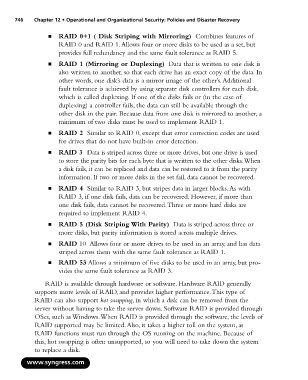Page 762 - StudyBook.pdf
P. 762
746 Chapter 12 • Operational and Organizational Security: Policies and Disaster Recovery
■ RAID 0+1 ( Disk Striping with Mirroring) Combines features of
RAID 0 and RAID 1.Allows four or more disks to be used as a set, but
provides full redundancy and the same fault tolerance as RAID 5.
■ RAID 1 (Mirroring or Duplexing) Data that is written to one disk is
also written to another, so that each drive has an exact copy of the data. In
other words, one disk’s data is a mirror image of the other’s.Additional
fault tolerance is achieved by using separate disk controllers for each disk,
which is called duplexing. If one of the disks fails or (in the case of
duplexing) a controller fails, the data can still be available through the
other disk in the pair. Because data from one disk is mirrored to another, a
minimum of two disks must be used to implement RAID 1.
■ RAID 2 Similar to RAID 0, except that error correction codes are used
for drives that do not have built-in error detection.
■ RAID 3 Data is striped across three or more drives, but one drive is used
to store the parity bits for each byte that is written to the other disks.When
a disk fails, it can be replaced and data can be restored to it from the parity
information. If two or more disks in the set fail, data cannot be recovered.
■ RAID 4 Similar to RAID 3, but stripes data in larger blocks.As with
RAID 3, if one disk fails, data can be recovered. However, if more than
one disk fails, data cannot be recovered.Three or more hard disks are
required to implement RAID 4.
■ RAID 5 (Disk Striping With Parity) Data is striped across three or
more disks, but parity information is stored across multiple drives.
■ RAID 10 Allows four or more drives to be used in an array, and has data
striped across them with the same fault tolerance as RAID 1.
■ RAID 53 Allows a minimum of five disks to be used in an array, but pro-
vides the same fault tolerance as RAID 3.
RAID is available through hardware or software. Hardware RAID generally
supports more levels of RAID, and provides higher performance.This type of
RAID can also support hot swapping, in which a disk can be removed from the
server without having to take the server down. Software RAID is provided through
OSes, such as Windows.When RAID is provided through the software, the levels of
RAID supported may be limited.Also, it takes a higher toll on the system, as
RAID functions must run through the OS running on the machine. Because of
this, hot swapping is often unsupported, so you will need to take down the system
to replace a disk.
www.syngress.com

